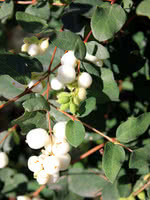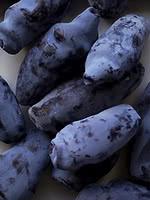Mon-Fri 9am - 5pm Mountain time
Common Snowberry vs Aurora Haskap (Honeyberry)
Symphoricarpos albus
Lonicera caerulea Aurora
Common Snowberry is a small deciduous shrub with characteristic white to pink flowers and clusters of white fruit.
This North American native species is very adaptable, and can be used for erosion control in riparian and restoration areas. Snowberry's fruit attracts wildlife, and livestock can consume the berries without issue.
Aurora Haskap is considered one of the top Haskap varieties, known for its excellent flavour and lower acidity, resulting in a sweeter taste. The flavour of Haskaps is generally described as a cross between a blueberry and a raspberry. Aurora Haskaps are well suited to fresh eating, freezing, baking, and preserves.
It produces high yields of large berries and the upright growth habit makes it suitable for mechanical harvesting. The berries are easily seen on the bush, making them easy to pick.
For optimal fruit production, cross-pollination is required. Haskaps need to be planted with a compatible variety. Compatibility is influenced by both bloom time and genetics.
Aurora Haskap is an early-pollinating variety and pairs well with Borealis, Tundra, Honey Bee, and Indigo Gem.
Common Snowberry Quick Facts
Aurora Haskap (Honeyberry) Quick Facts
Toxicity: berries toxic to humans

